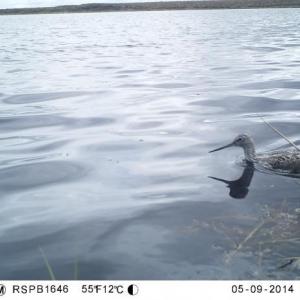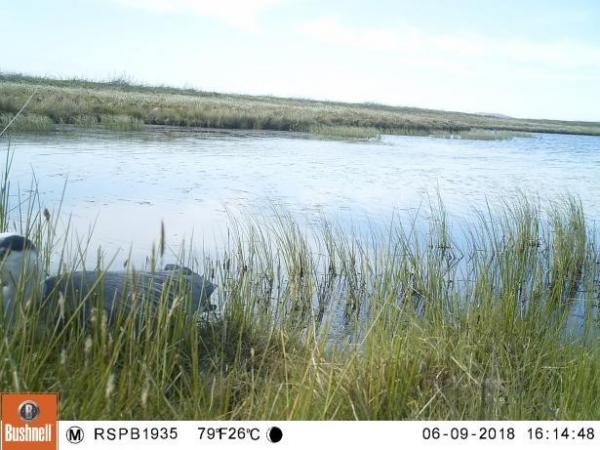Camera trapping

What’s the best way to see wildlife, if you are out and about? Should you rake about, looking for things (like a hen harrier), or just hide yourself in a good spot and wait (like a dragonfly nymph)? Over the years, I’ve used both approaches in my RSPB work. Walking long survey routes across moors and bogs certainly keeps you fit, and you can see a lot of wildlife. But in many ways, the ‘sit and wait’ approach is more aesthetic – because often, you see wildlife behaving more naturally, and sometimes, you see things you never expect.
One night years ago, I worked on a research study where we used the “sit & watch” approach to investigate black-throated diver chick survival. On this particular evening, during a 24-hour watch, the diver parents had already spent most of the day defending their loch against a persistent intruding diver – trying to muscle in on their territory – while the chick kept out of harm’s way, hiding in the aquatic vegetation. Eventually, the intruder flew off, pursued angrily (it seemed to me) by the resident pair. Many hours passed when nothing happened at all, then finally late at night, an adult diver flew in and landed on the loch. The chick swam out to greet it – only to be met by a direct attack – clearly, this was again, an intruding bird. As it got dark around midnight (on this June night in the Scottish Highlands), I could no longer use the telescope, just hearing the distant splashing and calling, before it went silent in the middle of the night, and I caught 40 winks. Around 3 am the light came up again – and there were the resident diver parents and chick, all peacefully asleep, on the loch like glass – all was well.
Nowadays, we can use modern technology – camera traps – to put in the hours, watching for wildlife. At RSPB’s Forsinard reserve, in the heart of the Flow Country of northern Scotland, we have been measuring how birds respond, when we re-introduced traditional trout angling at some lochs, working with the local angling club, Forsinard Flyfishers. At each loch we set up a camera trap, which sits and waits and watches, week after week, adding to our knowledge of how birds are using these lochs. Some birds – e.g. insect feeding species – may indirectly benefit from angling, since angling can reduce the number of trout, reducing predation pressure on insects, and hence indirectly increasing insect abundance. Although the camera traps’ main job is to gather data, along the way we also get some nice images, and, with all those hours sitting and waiting, they sometimes see things we rarely see…
Teal ducklings foraging for insects, on a glorious early morning at a Flow Country loch. This species, and other ducklings that eat insects, like scoters, might benefit if trout angling results in there being more insect prey available.
A foraging heron – a fish-feeder of course – reflected in the still water of the loch shallows, in near darkness. This bird might find there is less prey, if angling reduces trout populations. But herons also feed on other fish – like eels, which occur at some of the Flow Country lochs.

Whooper swans sometimes drop in at Flow Country lochs in the spring – presumably on their way to Iceland. In fact, the weather looks rather “Icelandic” in this photo, and the temperature definitely is. These birds are herbivores – feeding on aquatic plants – so they’re unlikely to be affected by angling. But they might open up the stands of aquatic plants which some insects use to hide from fish predation. Nearby is another loch named in Gaelic, “big loch of the swan” – no doubt visits by wild swans like these, have long been a feature of the area.

Things you rarely see, captured by a camera trap: a greenshank having a swim. Normally, this elegant wading bird gets around ... by wading.

Things you rarely see, captured by a camera trap: a heron having a snooze. Normally this shy bird jumps up & flies off at the slightest disturbance, uttering its other name, “Frank!”
Things you rarely see, captured by a camera trap: an aerial dogfight between a meadow pipit and (I think) a caddis fly (note the very long antennae). Life & death on a still July day in the Flow Country.
Words: Mark Hancock
